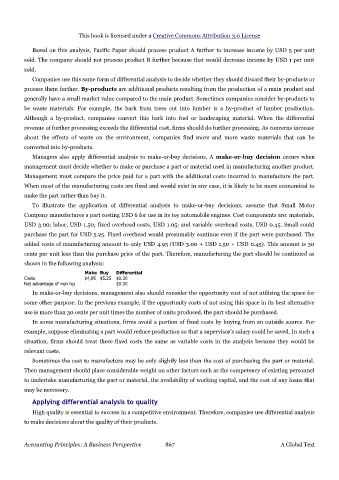Page 866 - Accounting Principles (A Business Perspective)
P. 866
This book is licensed under a Creative Commons Attribution 3.0 License
Based on this analysis, Pacific Paper should process product A further to increase income by USD 5 per unit
sold. The company should not process product B further because that would decrease income by USD 1 per unit
sold.
Companies use this same form of differential analysis to decide whether they should discard their by-products or
process them further. By-products are additional products resulting from the production of a main product and
generally have a small market value compared to the main product. Sometimes companies consider by-products to
be waste materials. For example, the bark from trees cut into lumber is a by-product of lumber production.
Although a by-product, companies convert this bark into fuel or landscaping material. When the differential
revenue of further processing exceeds the differential cost, firms should do further processing. As concerns increase
about the effects of waste on the environment, companies find more and more waste materials that can be
converted into by-products.
Managers also apply differential analysis to make-or-buy decisions. A make-or-buy decision occurs when
management must decide whether to make or purchase a part or material used in manufacturing another product.
Management must compare the price paid for a part with the additional costs incurred to manufacture the part.
When most of the manufacturing costs are fixed and would exist in any case, it is likely to be more economical to
make the part rather than buy it.
To illustrate the application of differential analysis to make-or-buy decisions, assume that Small Motor
Company manufactures a part costing USD 6 for use in its toy automobile engines. Cost components are: materials,
USD 3.00; labor, USD 1.50; fixed overhead costs, USD 1.05; and variable overhead costs, USD 0.45. Small could
purchase the part for USD 5.25. Fixed overhead would presumably continue even if the part were purchased. The
added costs of manufacturing amount to only USD 4.95 (USD 3.00 + USD 1.50 + USD 0.45). This amount is 30
cents per unit less than the purchase price of the part. Therefore, manufacturing the part should be continued as
shown in the following analysis:
Make Buy Differential
Costs $4,95 $5.25 $0.30
Net advantage of making $0.30
In make-or-buy decisions, management also should consider the opportunity cost of not utilizing the space for
some other purpose. In the previous example, if the opportunity costs of not using this space in its best alternative
use is more than 30 cents per unit times the number of units produced, the part should be purchased.
In some manufacturing situations, firms avoid a portion of fixed costs by buying from an outside source. For
example, suppose eliminating a part would reduce production so that a supervisor's salary could be saved. In such a
situation, firms should treat these fixed costs the same as variable costs in the analysis because they would be
relevant costs.
Sometimes the cost to manufacture may be only slightly less than the cost of purchasing the part or material.
Then management should place considerable weight on other factors such as the competency of existing personnel
to undertake manufacturing the part or material, the availability of working capital, and the cost of any loans that
may be necessary.
Applying differential analysis to quality
High quality is essential to success in a competitive environment. Therefore, companies use differential analysis
to make decisions about the quality of their products.
Accounting Principles: A Business Perspective 867 A Global Text

